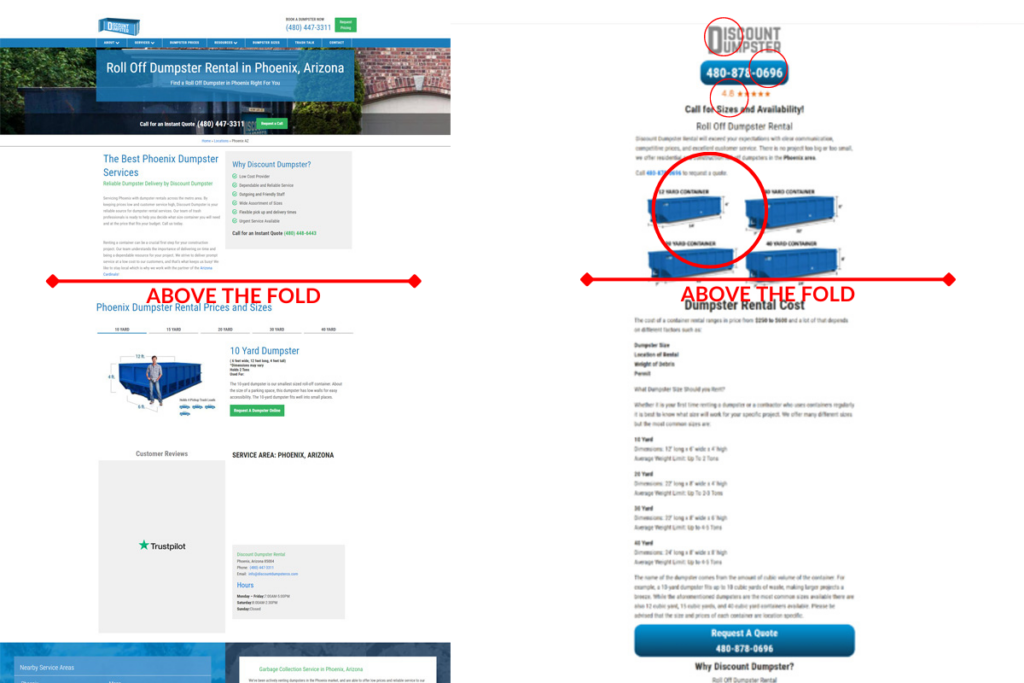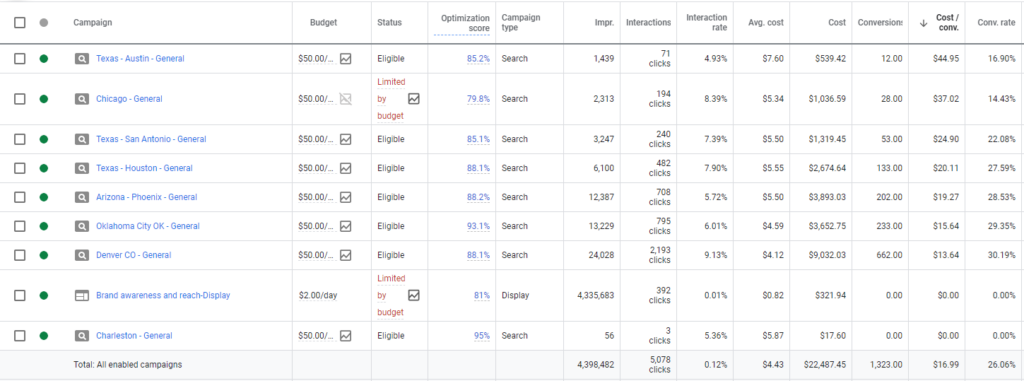The results are surprising, Quality Score and Cost Per Click are more clearly correlated when you look at Exact Match keywords.
close

Six Agencies came and went without positively impacting the bottom line. Unfortunately, this is the case time and time again. In another role, it was the same story.
Can you imagine spending $5,000 for 17 phone calls? For context, the industry average for a phone call is $60.93; with a few changes to our ads account, we reduced the average cost to $16.87 while improving call quality.
After taking over the account. Here is what happened. Costs dropped by a lot.
We reorganized the structure of the groups into SKAGs, also known as single keyword ad groups, and optimized bids.


The average cost per conversion went from $284 to $16.87, a 94.1% change.
7.64 X 3.13 = 23.9 times more leads with the same budget
Companies with a larger budget and the resources to convert users at an earlier stage of the funnel might find question words an excellent place to start advertising along the consumer journey.
For example, blogs starting with "How to" or "Best" could be used as top-of-funnel touchpoints.
You could engage, retarget, and capture leads with top-of-funnel content. Additionally, your sales team could follow up with leads at a later date. However, most small business owners do not have the resources to spend on top-of-funnel search queries.
Additional Funnel Opportunities

Because of the use of Callrail and Salesforce, I could track conversions end to end and determine which calls resulted in a sale.
After doing data analysis through Tableau, I found that top-of-funnel searchers turned into customers only after additional engagements on later dates. However, not at the same rate as the first-time, bottom-of-funnel callers. This is because people at the bottom of the funnel do not need any more convincing. They're ready to order.
Here are some of the keyword negatives:
"Prices for Dumpster Rental" - Phrase Match - "Dumpster Rental
Explanation: Someone looking for "Prices" is still in the exploratory phase; they will likely call around asking for prices and may or may not end up ordering with us.
"Cheap Dumpster Rentals Phoenix AZ" - Phrase Match - "Dumpster Rentals"
Explanation: Someone looking for "cheap" has a subjective opinion about what cheap means. You and I have different opinions on what cheap means.
Additional Funnel Opportunities
If your quality scores are bad and your landing page is not optimized, costs can get out of hand fast.
Automated campaigns need hundreds of conversions over a short period for automated strategies to work effectively. Google can get by with as little as 20, but the more you have, the better. One of the advantages of automated bidding strategies is that they can use data not publicly available to advertisers, such as the previous search queries and search intent; this can theoretically optimize a campaign.
However, as an advertiser, you lack control over what queries or information the automated strategy is optimizing for; often, you end up bidding on queries that would result in your desired action(phone call) but may or may not result in a sale.
For example, an automated strategy focused on phone calls will try to get calls no matter the user's intent (In this case, we want users to order a dumpster). It could optimize for people trying to call your competitor or looking for jobs. Or maybe the caller is curious about the dimensions of a similar product.
Importantly, semi-relevant queries are not inherently a waste of money; they could be opportunities to increase revenue. But you also have to ask yourself if you want to pay Google money to act as a Q&A phone service.
I've found that when you look at the search query report, as seen in one of the sections above, you will find that the automated bidding strategy was bidding for search queries from people asking questions or looking for blog content "how-tos."
Once again, this strategy can work if you have the resources to answer questions or offer signup rewards. But you're also paying to answer those questions.
This feels like a double whammy to me; paying twice as much for queries that have a lower probability of becoming a customer.
Additional Funnel Opportunities
In the example below, there are queries for the same market at different prices. The automated campaign used factors not publicly available to bid up the same query based on the premise that the person had a higher probability of making a phone call. However, the conversion rate did not increase in the automated campaigns. What ended up happening is the costs went up, and that's about it.


Another effective way to reduce costs is optimizing a campaign for the Google Adwords Quality Score, which is covered in another case study.
If you reduce cost per click from $12 to $4(3x), you are on the right track, but if you also increase conversions rates from 4% to 8%(2x), then you've effectively done the following to your conversions
3x2 = 6x more conversions for the same cost.
While I would have been happy with an 8% conversion rate, the results were much better. The last agency directed users to a standard location page, which was a mistake. This standard page had a horrible PPC conversion rate. However, that page's organic search conversion rate was 7-12%. It's speculative to wonder if the irrelevant phrases from the automated campaign took the conversion rates down instead of up.
You can see the original Phoenix Metro landing page here. It has a conversion rate of 1.48%, with a Cost Per Phone call of $400. It did not change very much between October and November 2019.


From the screenshot above, the conversion rate between September 2018 to February 2020 was roughly $14,000 in ad spend and averaged a conversion rate of 3.41% over its lifetime. Resulting in 66 phone calls at a lifetime average cost of $205.78 per call. If one were to double the conversion rate, then one could double the number of leads received with the same ad spend.
7% would have been fantastic, but I could reach an average 26% conversion rate through trial and error while A/B testing pages on Unbounce. Call quality actually went up during the same timeframe, as we were negativing keywords that were irrelevant to our intended goal, phone calls, and sales.
Experimenting with colors and structure, as I did with UX experiments in Google Optimize also helped the conversion rate.
On a fundamental level, the things that matter the most on a highly converting PPC landing page are the first things a user will see above the fold. The bullets below are the design essentials for above-the-fold content.
Conversion Rate Optimization Essentials

Roughly one year later and with $24,000 in Ad spend, the Cost per Acquisition was at a profitable $16.99 for every unique phone call.
7.64 X 3.13 = 23.9 Times More Leads With The Same Budget

The results are surprising, Quality Score and Cost Per Click are more clearly correlated when you look at Exact Match keywords.
I love WordPress for its customizations. Styling code snippets enhances user perceptions. Copy and paste the code below to style your WordPress code blocks.
The code snippet plugin changed my life. I no longer edit the raw PHP files to add simple functions like titles to users' profiles.
By restructuring your account and using hyper-targeted ad text, CPA can be reduced.
YMYL stands for "Your Money or Your Life." Google uses YMYL to help understand if a web page's main content could impact people's safety, health, or financial well-being.
With slight modifications to Optinmonster's native A/B testing capabilities, it becomes an excellent CRO testing tool.

The results are surprising, Quality Score and Cost Per Click are more clearly correlated when you look at Exact Match keywords.
I love WordPress for its customizations. Styling code snippets enhances user perceptions. Copy and paste the code below to style your WordPress code blocks.
The code snippet plugin changed my life. I no longer edit the raw PHP files to add simple functions like titles to users' profiles.
By restructuring your account and using hyper-targeted ad text, CPA can be reduced.
YMYL stands for "Your Money or Your Life." Google uses YMYL to help understand if a web page's main content could impact people's safety, health, or financial well-being.
With slight modifications to Optinmonster's native A/B testing capabilities, it becomes an excellent CRO testing tool.
